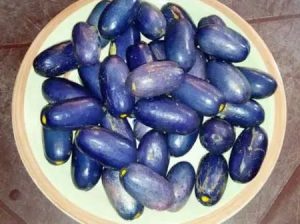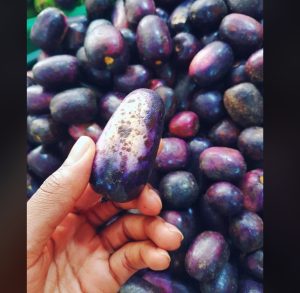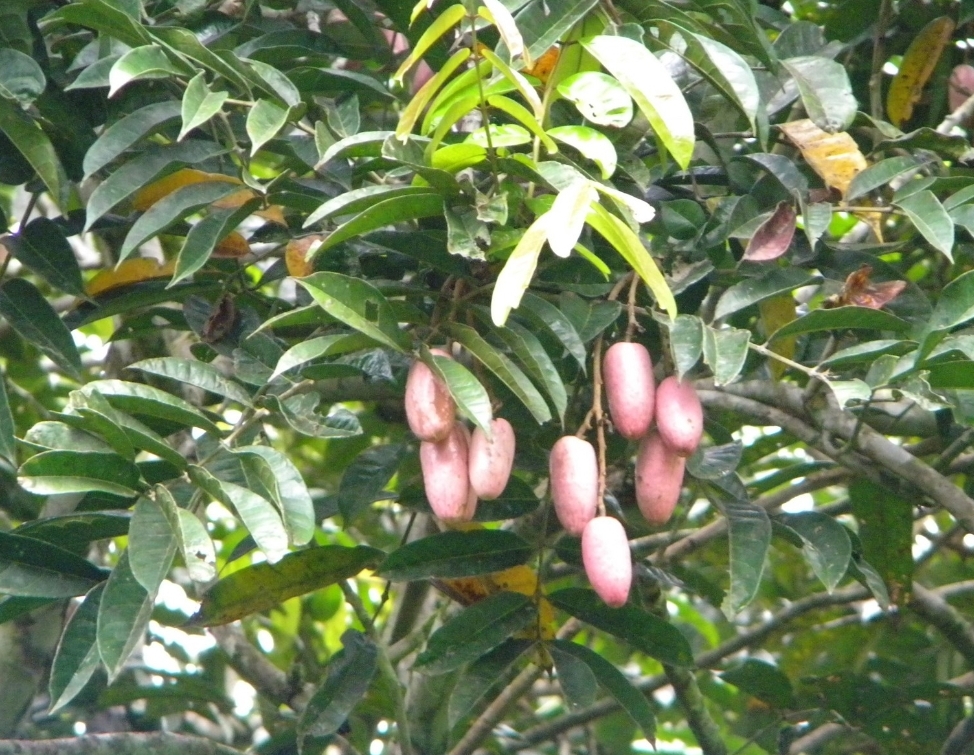African Pear otherwise called bush pear or plum, or addressed scientifically by its;
Preferred Botanical Name as: Dacryodes edulis
Preferred Common Name: African Pear, Bush pear
Local Common Names:
- Ibibio: Eben
- Yoruba: Elemi
- Igbo: Ube
It also goes by other different names in different tribes and regions.
Origin Of African Pear

African Pear or Dacryodes edulis is a fruit tree native to Africa, sometimes called Safou (Cameroon), or by its other names: bush pear, plum, or butter fruit.
Is an evergreen tree, that at full maturity and height its trunk can attain a height of 18–40 meters in the forest but not exceeding 12 meters in plantations.
The African pear tree leaf has 5-8 pairs of leaflets, and it is usually a compound of leaves and it is a perennial plant.
The African pear tree bark is pale gray and rough; it usually brings out tiny drops of resins. The tree trunk is has a deep, dense crown.
The bush pear flower’s arrangement follows a large inflorescence. The fruit is an ellipsoidal drupe that varies from 4 to 12 cm.
The African pear skin is a small cylindrical-like dark blue, dark purple, or violet fruit when ripe, and pink when unripe. The flesh is pale to light green.
The inside of the fruit is pale to light green. At the beginning of the rainy season, the tree flowers and bears fruits 2 to 5 months after flowering.
African pear has its origins in Central Africa and the Gulf of Guinea. The plant can be found in most Western African countries.
It can be easily planted, and many parts of Cameroon and Nigeria grow it.
Nutrient Composition Of African Pear
African pear is scientifically affirmed to be very rich in essential nutrients, that are great for human development and wellness.
Some of these nutrients include, antioxidants, vitamins, and minerals that help to fight health challenges ranging from cancer prevention to bone and skin improvement and immune boosting.
Below are the nutrient composition of 100g African pears:
- Calories 409
- Total Fat 18g
- Total Carbohydrate 11g
- Protein 2g
- Dietary Fiber 2.71g
- Vitamin C 22.15mg
- Sodium 0.87g
- Potassium 1.66g
- Calcium 0.13g
- Iron 1.7g
- Phosphorus 10.34g
- Zinc 0.31mg
- Manganese 0.32mg
Medicinal Properties and Uses Of African Pear

Bush pear contains lipids that are healthy and do not result in excessive fat.
The lipids do not have cholesterol; hence they do not cause obesity, or any allergic reaction.
Hence they are ideal for both adults and children. Below are the various uses of bush pear:
- The seeds can serve as a high blood pressure moderator. (Simply, sun-dry seeds and grind into powdered form for high blood pressure control.) Persons living with hypertension can add it to their tea.
- African tree fruits act as an antioxidant.
- Plum contains vitamin C, which aids in improving the immune system to fight against diseases and to remain healthy.
- Bush pear contains vitamin B5, known as Pantothenate that helps synthesize carbohydrates, protein, and fats; as well as aid in producing red blood cells and adrenal hormones.
- Plums are rich in oil, and the fleshy part of the fruit can treat skin diseases such as ringworm, craw-craw, and other mild related skin diseases.
- The fiber content in bush pear improves digestion and reduces constipation.
- Its seed can reduce the risk of stroke.
- Calcium and phosphorus present in the fruit are essential nutrients for formation of healthy bones and teeth.
- This fruit help fight against cancer due to the phytochemicals that are present in it. Regular consumption will reduce cancer risk.
- Bush pears are hypoallergenic fruits (that means they hardly cause an allergic reaction)
How To Grow African Pear and
Yield Information
African pear trees usually will bear fruit in 4 – 5 years. A plum tree can yield up to 20-50 kilos of fruit. Each tree can produce up to 200 fruits.
Nursery and Transplant Requirements
If you are transplanting an African pear tree, your first step is to find a suitable new site for it.
- It will require a well worked, well-rotted compost or manure into the soil.
- Dig a hole, with the width of the hole twice the tree’s root and its depth half the root of the tree.
- Put a tree stake in place, let the stake be at least 2 feets deep when driven into the ground. Drive the stake into the side of the hole
- Proceed to placing the plant in the hole, the soil mark from the nursery pot should be on the surface level and spread the roots in all directions.
- To ensure no air pockets among the roots, re-fill the hole with little native soil and compost or organic planting mix.
- Water in the soil and create a modest soil basin around the trunk to hold water at watering time.
- Use tree ties to support the tree with the stake.
- After planting, water tree thoroughly.
Soil and Sun Requirements Of African Pear
African pear is hardly selective, hence a delight. It can grow in light (sandy), medium (loamy), and heavy (clay) soils and can grow in nutritionally poor soil.
Suitable pH is neutral and basic (alkaline) soils. It prefers a pH in the range of 5 – 6.5 and moist or wet soil. It requires full sun.
Watering Requirements Of African Pear
It prefers a mean annual rainfall in the range of 1,200 – 3,000mm but can tolerate 1,000 – 5,000mm.
It is best to water the plant at least once every week during the dry season.
Planting and Spacing Requirements Of African Pear
When planting bush pear, the tree require a spacing of up to 6 meters apart.
Spacing the trees will allow each tree to spread its branches and maximize its own food.
Harvesting African Pear
African pear can begin yielding from about 5 – 6 years old.
When ripe, the color changes from pink to deep purple.
You can harvest plums by plucking the fruit from the tree with your hands mostimes that will require climbing.
Storage Of African Pear
Ripe pear stored under room temperature will last only a few days to a week.
Refrigeration can spare it up to two weeks. If stored in a hot room, it softens.
Pear seeds are usually dried, and you can store them for some months.
Disease and Pest Of African Pear
Anthracnose
This plant can also be affected by disease though rarely. It symptoms may include chlorotic and necrotic spots, dead leaf tip, defoliation, brown or purple lesions on new shoots.
A fungus causes Anthracnose. You can manage it by:
- Pruning dead twigs and branches from the tree before fungi produce spores
- Knocking dead leaves out of the canopy
- Keep harvested fruit dry and cool.
Conclusion
The African pear is a native fruit that is highly nutritious and eaten by all ages, races, including children and adults.
The bush pear has butter-like flesh when boiled or roasted. You can eat raw too when ripe.
It can go with bread, corn, garri or just solo. It is a sumptuous fruit indeed and a healthy addition to your diet.
